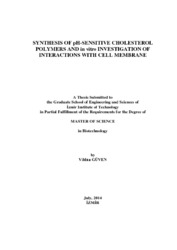Please use this identifier to cite or link to this item:
https://hdl.handle.net/11147/4183Full metadata record
| DC Field | Value | Language |
|---|---|---|
| dc.contributor.advisor | Bulmuş Zareie, Esma Volga | |
| dc.contributor.author | Güven, Vildan | - |
| dc.date.accessioned | 2014-11-18T12:19:08Z | |
| dc.date.available | 2014-11-18T12:19:08Z | |
| dc.date.issued | 2014 | |
| dc.identifier.uri | http://hdl.handle.net/11147/4183 | |
| dc.description | Thesis (Master)--Izmir Institute of Technology, Biotechnology, Izmir, 2014 | en_US |
| dc.description | Includes bibliographical references (leaves: 58-61) | en_US |
| dc.description | Text in English; Abstract: Turkish and English | en_US |
| dc.description | xii, 65 leaves | en_US |
| dc.description.abstract | The aim of this thesis is to synthesize pH-sensitive, cholesterol containing polymers via reversible addition fragmentation chain transfer (RAFT) polymerization, as potential membrane-destabilizing agents for intracellular drug delivery applications and investigate interaction of these polymers with cell membrane. For this purpose, cholesteryl methacrylate (CMA) and 2-((tert-butoxycarbony)(2-((tert-butoxycarbonyl) amino) ethyl) amino)ethyl methacrylate (Boc-AEAEMA) were first synthesized. CMA was copolymerized with t-butyl methacrylate (t-BMA) or Boc-AEAEMA via RAFT polymerization to produce cholesterol containing copolymers having varying molecular weights and compositions. Copolymers were characterized using 1H-NMR spectroscopy and gel permeation chromatography (GPC). Linear increase in ln [M]0/[M] with polymerization time, and Mn with monomer conversion indicated the RAFT-controlled copolymerizations under the conditions tested. P(t-BMA-co-CMA) and P(Boc-AEAEMA-co-CMA) copolymers were hydrolyzed to methacrylic acid-co-CMA (p(MAA-co-CMA) and p(AEAEMA-co-CMA) copolymers, respectively, to obtain water soluble, pH-sensitive copolymers. The pH-responsive behavior of copolymers was demonstrated via UV−visible spectroscopy and dynamic light scattering measurements. These measurements revealed that (p(MAA-co-CMA) copolymers having 2 and 4 mol% CMA form nanoparticles at pH 5.5 while they exist as unimers at pH 7.4. Copolymers having 8% CMA form aggregates at both pH values. Hemolysis assays revealed that p(MAA-co-CMA) having a molecular weight above 20,000 g/mol did not show pH-dependent hemolytic activity regardless of CMA content. The cell viability results (obtained by MTT assay) indicated that p(MAA-co-CMA) at 250 μg/ml concentration is not cytotoxic to NIH3T3 cell line. | en_US |
| dc.language.iso | en | en_US |
| dc.publisher | Izmir Institute of Technology | en_US |
| dc.rights | info:eu-repo/semantics/openAccess | en_US |
| dc.subject.lcsh | Polymers in medicine | en_US |
| dc.subject.lcsh | Cell membranes | en_US |
| dc.title | Synthesis of pH-sensitive cholesterol polymers and in vitro investigation of interactions with cell membrane | en_US |
| dc.title.alternative | ph-Duyarlı kolesterol polimerlerinin sentezi ve hücre membranıyla etkileşimlerinin in vitro incelenmesi | en_US |
| dc.type | Master Thesis | en_US |
| dc.institutionauthor | Güven, Vildan | - |
| dc.department | Thesis (Master)--İzmir Institute of Technology, Bioengineering | en_US |
| dc.relation.publicationcategory | Tez | en_US |
| item.grantfulltext | open | - |
| item.openairecristype | http://purl.org/coar/resource_type/c_18cf | - |
| item.cerifentitytype | Publications | - |
| item.openairetype | Master Thesis | - |
| item.languageiso639-1 | en | - |
| item.fulltext | With Fulltext | - |
| Appears in Collections: | Master Degree / Yüksek Lisans Tezleri | |
Files in This Item:
| File | Description | Size | Format | |
|---|---|---|---|---|
| 10013240.pdf | MasterThesis | 1.78 MB | Adobe PDF |  View/Open |
CORE Recommender
Page view(s)
61,762
checked on Apr 22, 2024
Download(s)
20
checked on Apr 22, 2024
Google ScholarTM
Check
Items in GCRIS Repository are protected by copyright, with all rights reserved, unless otherwise indicated.